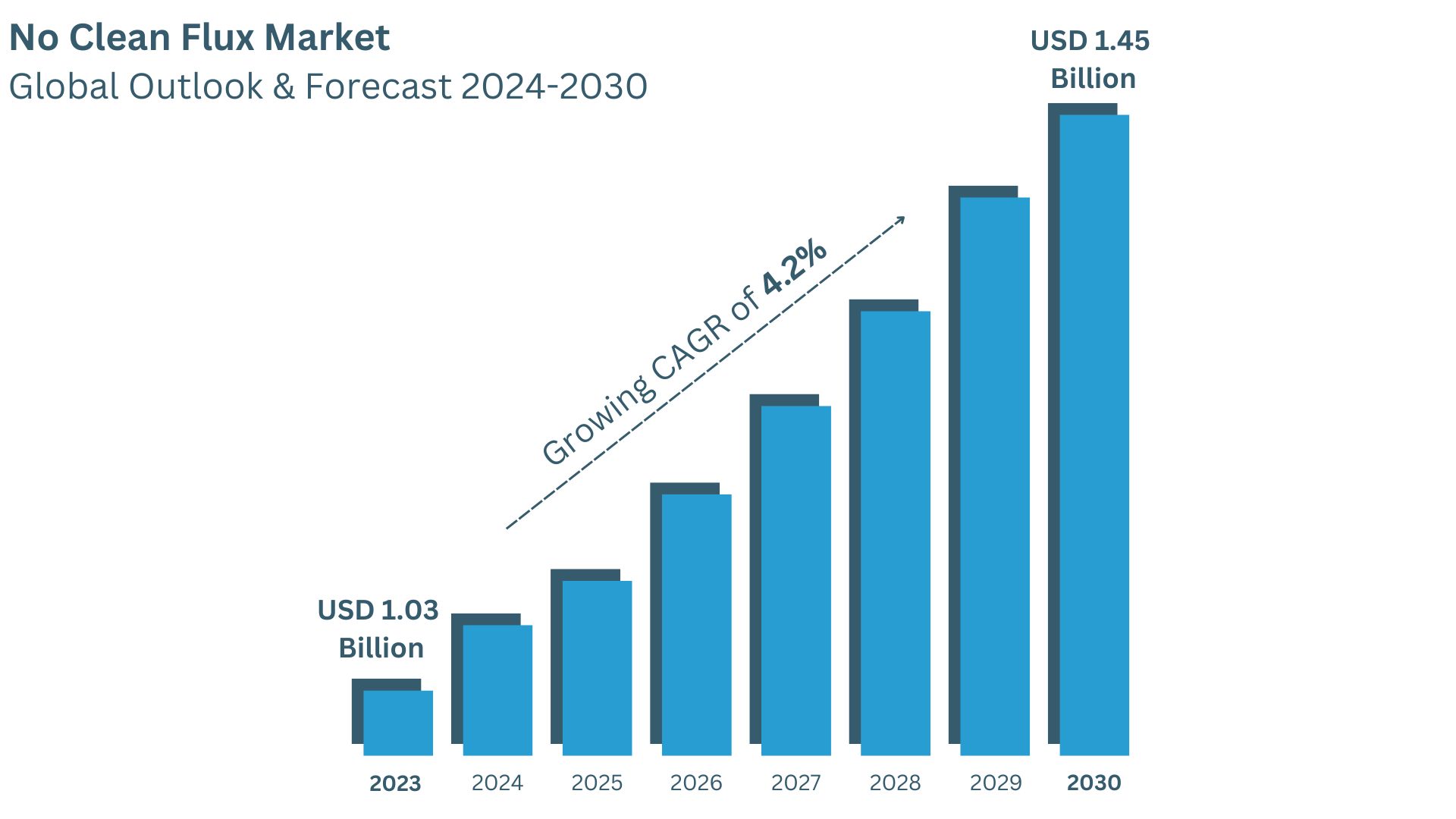TOP CATEGORY: Chemicals & Materials | Life Sciences | Banking & Finance | ICT Media
The global no clean flux market was valued at USD 1.03 billion in 2023 and is projected to reach USD 1.45 billion by 2030, growing at a Compound Annual Growth Rate (CAGR) of 4.2% during the forecast period (2024-2030). The influence of COVID-19 and the Russia-Ukraine War were considered while estimating market sizes.
No clean flux refers to a type of flux used in soldering processes that is designed to leave minimal residue after soldering is completed. Flux is a chemical substance used to clean and prepare metal surfaces for soldering by preventing oxidation and promoting solder wetting.
No clean flux is formulated with ingredients that minimize the formation of residues during soldering. Unlike traditional fluxes that require thorough cleaning after soldering to remove potentially corrosive residues, no clean flux is designed to leave behind a residue that is non-corrosive and non-conductive. This residue is generally considered safe to leave on the circuit board without compromising its performance or reliability. Therefore, no clean flux is particularly useful in applications where thorough post-solder cleaning may be challenging or impractical, such as in high-volume electronics manufacturing or where components are sensitive to moisture or cleaning agents.
Impact of COVID-19: The estimation of market sizes considered the influence of the COVID-19 pandemic, which disrupted supply chains and manufacturing operations, affecting market growth and demand.
Russia-Ukraine War Influence: Geopolitical factors such as the Russia-Ukraine war were taken into account, potentially impacting raw material supply chains and market stability.
Market Drivers: Increasing adoption of no clean flux in electronics manufacturing due to its benefits such as reduced cleaning requirements, lower environmental impact, and improved solder joint reliability is driving market growth.
Technological Advancements: Continuous advancements in soldering technologies and formulations of no clean flux to meet evolving industry standards and performance requirements are enhancing market attractiveness.
Application Diversity: No clean flux is widely used in various applications including printed circuit board (PCB) assembly, semiconductor packaging, and automotive electronics, contributing to market expansion.
Environmental Regulations: Compliance with stringent environmental regulations regarding the use and disposal of soldering materials is shaping product development and market strategies.
Challenges: Despite growth prospects, challenges such as competition from alternative flux types, variability in quality standards across regions, and price volatility of raw materials could impact market dynamics.

The global key manufacturers of No Clean Flux include Senju, Alent (Alpha), Tamura, Henkel, Indium, Kester, Shengmao, Inventec and AIM Solder, etc. in 2023, the global top five players have a share approximately % in terms of revenue.
This report aims to provide a comprehensive presentation of the global market for No Clean Flux, with both quantitative and qualitative analysis, to help readers develop business/growth strategies, assess the market competitive situation, analyze their position in the current marketplace, and make informed business decisions regarding No Clean Flux. This report contains market size and forecasts of No Clean Flux in global, including the following market information:
MARKET MONITOR GLOBAL, INC (MMG) has surveyed the No Clean Flux manufacturers, suppliers, distributors and industry experts on this industry, involving the sales, revenue, demand, price change, product type, recent development and plan, industry trends, drivers, challenges, obstacles, and potential risks.
Total Market by Segment:
Global No Clean Flux Market, by Type, 2019-2024, 2025-2030 ($ Millions) & (Tons)
Global No Clean Flux Market Segment Percentages, by Type, 2023 (%)
Global No Clean Flux Market, by Application, 2019-2024, 2025-2030 ($ Millions) & (Tons)
Global No Clean Flux Market Segment Percentages, by Application, 2023 (%)
Global No Clean Flux Market, By Region and Country, 2019-2024, 2025-2030 ($ Millions) & (Tons)
Global No Clean Flux Market Segment Percentages, By Region and Country, 2023 (%)
Competitor Analysis
The report also provides analysis of leading market participants including:
Further, the report presents profiles of competitors in the market, key players include:
Outline of Major Chapters:
Chapter 1: Introduces the definition of No Clean Flux, market overview.
Chapter 2: Global No Clean Flux market size in revenue and volume.
Chapter 3: Detailed analysis of No Clean Flux manufacturers competitive landscape, price, sales and revenue market share, latest development plan, merger, and acquisition information, etc.
Chapter 4: Provides the analysis of various market segments by type, covering the market size and development potential of each market segment, to help readers find the blue ocean market in different market segments.
Chapter 5: Provides the analysis of various market segments by application, covering the market size and development potential of each market segment, to help readers find the blue ocean market in different downstream markets.
Chapter 6: Sales of No Clean Flux in regional level and country level. It provides a quantitative analysis of the market size and development potential of each region and its main countries and introduces the market development, future development prospects, market space of each country in the world.
Chapter 7: Provides profiles of key players, introducing the basic situation of the main companies in the market in detail, including product sales, revenue, price, gross margin, product introduction, recent development, etc.
Chapter 8: Global No Clean Flux capacity by region & country.
Chapter 9: Introduces the market dynamics, latest developments of the market, the driving factors and restrictive factors of the market, the challenges and risks faced by manufacturers in the industry, and the analysis of relevant policies in the industry.
Chapter 10: Analysis of industrial chain, including the upstream and downstream of the industry.
Chapter 11: The main points and conclusions of the report.